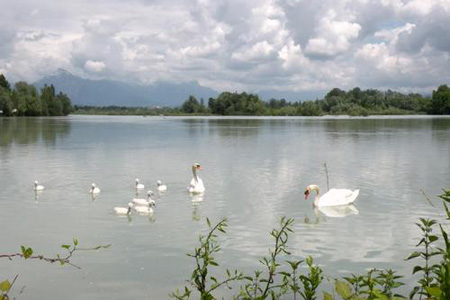| Card n. | Description | Locality | Linked sites |
| 69 | Busche Dam | Cesiomaggiore - Lentiai | 114 - 34 |
| file .pdf | Naturalistic Interest Sites (SIN) | Google maps |
 |
- Description
- How to get there
- Interesting facts
- Bibliography
At the point where the Piave takes off sharply in the direction of the Montello, an artificial lake has been created. In Busche, between the municipalities of Lentiai and Cesiomaggiore, there is a dam that provides water to the electrical power plants of Quero and Pederobba and the irrigation channels of the reclamation consortia of the Po plain. Over the years, the area has acquired such a natural appearance that it is the second most important lake in the province in terms of ornithological interest, becoming an important site for both migratory and sedentary bird species. Busche was once a market town, where duties were paid, together with Cesana (34 HAA/ES), situated opposite it. Products were brought here from the plain, and both cloth and foodstuffs departed here for Treviso and Venice. Today it is a hard working village that boasts a host of craft businesses and a flourishing dairy and cheese-making industry, where Piave DOP (Protected Denomination of Origin) label cheese can be found.
Along the SS50, at km 31 you will find the village of Busche, an important point on the Val Belluna traffic network; the bridge over the dam links the villages on the right bank of the Piave with those on the left, and together with the Quero – Vas bridge and the San Felice bridge between Trichiana and Sedico, form the three crossings over the sacred river before those at the town of Belluno itself.
ACCESSIBLE: yes
MUNICIPALITY: Cesiomaggiore/Lentiai
PLACE: Lake di Busche
GEOGRAPHICAL COORDINATES: X 1731310 - Y 5102857
PROVINCE: Belluno
FILE COMPILED BY: Nicoletti/Abordi
Piave cheese has a rich, genuine, traditional flavour. The name derives from the river that begins on Monte Peralba in Val Visdende, in the Comelico area, the northernmost part of the province of Belluno. From there the Piave winds its way down towards the valley bottom, first into the Cadore and then into the Belluno basin, between Belluno and Feltre, where the river flows more slowly until it meets the plain at the foot of the Veneto Pre-Alps in the province of Treviso.
There is no name, therefore, that could better represent the typical cheese of Belluno, the result of the dairy and cheese making tradition characteristic of the area crossed right through by this ancient river, which provides the milk required to make the cheese. Piave cheese has a distinctive, full flavour that intensifies as it matures, maintaining a characteristic taste that makes it truly unique.
Today the origin of the product is guaranteed by special lists that cattle breeders, milk producers, cheese makers and cheese maturers must register with. Piave is a hard, cooked paste cheese, made in a round wheel and matured for 20 to 60 days for the Fresco version, for 61 to 120 days for the Mezzano version, and over 120 days for the Vecchio version.
Census of the minor nature areas in the Veneto Region, ARPAV 2003
Regulations for fishing in the inland public waters of the province of Belluno, Province of Belluno, 2000
M. Cassol, G. Nadalet, Interessanti avvistamenti in provincia di Belluno. Riv. It. Ornit, 1989
M. Cassol, L’avifauna del Piave nella Val Belluna. Dolomiti, 1987
Natura 2000 Network standard form for Special Protection Zones (SPA) IT 3230032 Busche Lake – Osiery of Celarda - Fountains
C. Lasen, C. Argenti, Provincial Territorial Plan of the Province of Belluno: Biotopes project
Annual report on water quality in the province of Belluno, report on the state of the environment Province of Belluno, ARPAV

